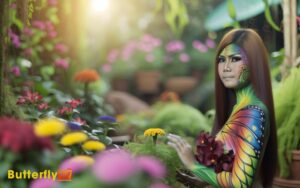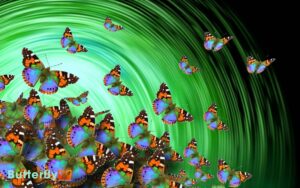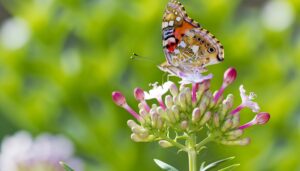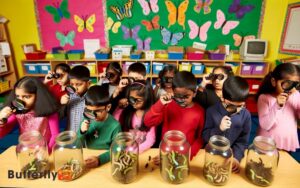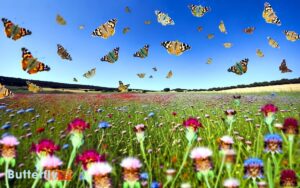How to Make Sugar Water for Painted Lady Butterflies? Guide!
To make sugar water for Painted Lady butterflies, gather distilled water and granulated white sugar. Importance is vital; avoid honey or brown sugar due to potential contaminants.
Measure one part sugar to ten parts water. Heat the water to a rolling boil to guarantee sterility, then add sugar and stir until fully dissolved. Let the solution cool swiftly using an ice bath.
Fill a clean, sterile feeder with the liquid and place it in a sunny, elevated spot near flowering plants. Regularly clean the feeder and monitor sugar water levels. By doing this, you’ll create an inviting environment for the butterflies.
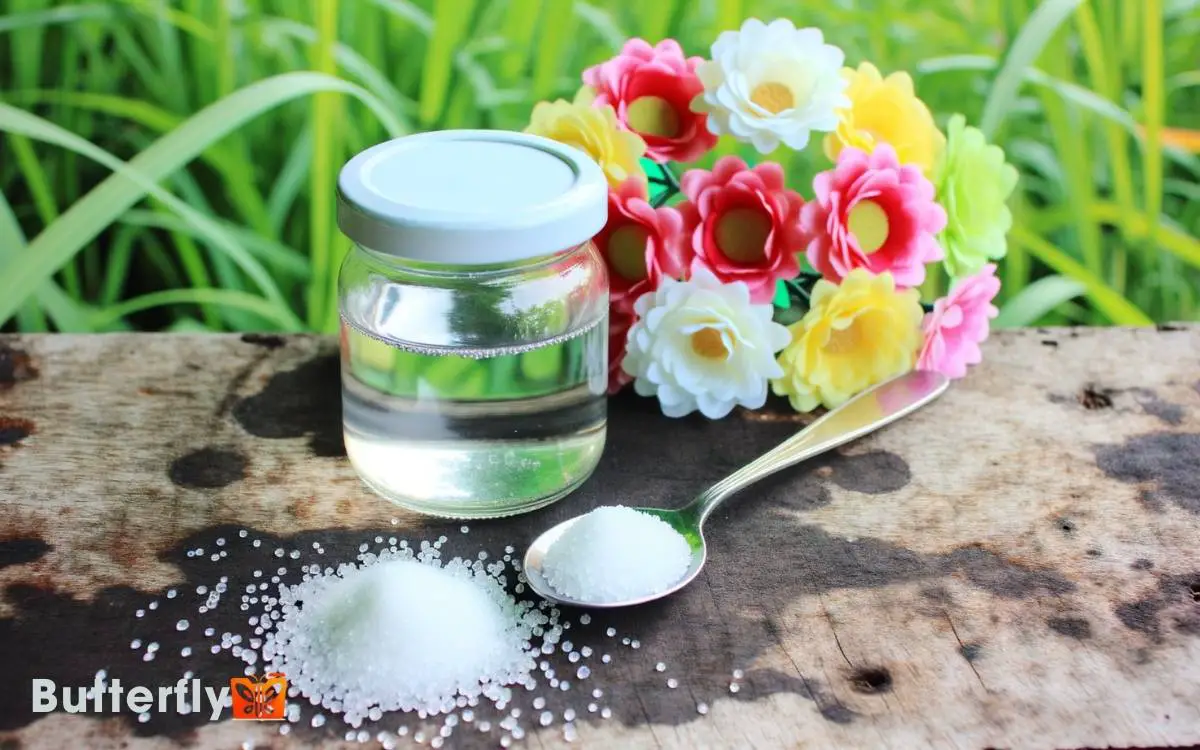
Key Takeaways
Gather Your Supplies
To begin making sugar water for Painted Lady butterflies, one needs to gather a clean container, white granulated sugar, and distilled water. The container must be free of contaminants to prevent introducing harmful substances.
White granulated sugar is chosen for its purity, ensuring no additives interfere with the butterflies’ digestion. Distilled water is essential as it lacks impurities that might affect the solution’s quality.
By using these specific supplies, one creates an environment conducive to the butterflies’ health. Each item serves a distinct purpose, contributing to a nutrient-rich solution that mimics natural nectar.
Adhering to these specific materials will optimize the butterflies’ energy intake and support their overall well-being.
Choose the Right Sugar
Selecting the appropriate type of sugar is paramount to ensuring the nutritional adequacy of the sugar water for Painted Lady butterflies. Sucrose is the best sugar due to its similarity to nectar composition found in nature.
Granulated white sugar, easily accessible and pure, serves as a suitable source. Alternative sugars like honey or brown sugar can introduce harmful additives and impurities, making them less ideal.
| Sugar Type | Pros | Cons |
|---|---|---|
| Granulated White | Pure, easily dissolvable | None significant |
| Honey | Natural, contains trace nutrients | May contain harmful additives |
| Brown Sugar | Contains molasses | Impurities and non-ideal composition |
This table highlights the importance of choosing granulated white sugar to avoid potential risks associated with other sugar types.
Measure the Ingredients
Accurately measuring the ingredients is crucial to creating a balanced and effective sugar water solution for Painted Lady butterflies. Precise measurements guarantee the solution maintains the proper concentration, maximizing the butterflies’ energy intake and hydration.
Key measurement guidelines include:
- Sugar: Use granulated white sugar for consistency.
- Water: Opt for distilled or previously boiled water to avoid contaminants.
- Ratio: Maintain a ratio of 1 part sugar to 10 parts water for best results.
- Measuring Tools: Utilize a kitchen scale and graduated cylinder for accuracy.
- Temperature: Ensure the water is at room temperature before mixing.
Mix the Sugar and Water
Once the ingredients are measured accurately, mix the granulated white sugar with distilled or previously boiled water at room temperature.
Stir the mixture thoroughly using a clean, non-reactive utensil, guaranteeing the sugar dissolves completely. Observing the solution for any undissolved sugar granules is crucial; complete dissolution is essential for the butterflies’ digestion and hydration.
A homogenous solution indicates proper mixing, crucial for consistent nutrient availability to the painted lady butterflies. Incomplete dissolution could lead to uneven sugar distribution, potentially harming the butterflies.
Employing a precise ratio and meticulous stirring promotes excellent health and feeding behavior in these insects. This method ensures the solution’s efficacy, aligning with best practices for entomological care and maintenance.
Boil the Solution
To guarantee sterility and enhance solubility, bring the sugar-water solution to a rolling boil. This step guarantees the sugar fully dissolves and any potential contaminants are eradicated.
Utilize a clean saucepan and medium-high heat to achieve best results. Monitor the solution closely to prevent over-boiling, which could lead to caramelization and alter the composition.
Key points to remember:
- Rolling boil: Defined by consistent, vigorous bubbling.
- Sterility: Eliminates microbial contaminants.
- Solubility: Ensures complete dissolution of sugar.
- Timing: Boil for approximately 2-3 minutes.
- Safety: Handle hot solutions with caution to avoid burns.
Cool the Mixture
After boiling, the sugar-water solution needs to be cooled rapidly to prevent microbial growth and maintain its chemical stability. Cooling the mixture quickly limits the time available for bacteria or fungi to colonize.
To expedite the cooling process, transfer the hot solution into a sterile, heat-resistant container.
Place this container in an ice bath, making sure the water level is below the rim to avoid contamination. Stir the solution gently to facilitate even cooling and to prevent the formation of hot spots.
Monitoring the temperature with a sterile thermometer guarantees the mixture reaches room temperature. Rapid cooling is essential to maintaining the integrity of the sugar-water solution, making it safe and effective for Painted Lady butterflies.
Fill the Feeder
With the sugar-water solution cooled to room temperature, the next step involves cautiously pouring it into a clean, sterile feeder designed for butterflies.
Guaranteeing the feeder is sanitized reduces the risk of harmful bacterial growth, which can negatively impact the Painted Lady butterflies.
Key considerations for filling the feeder include:
- Volume Control: Avoid overfilling to prevent spills.
- Feeder Type: Use feeders specifically designed for butterflies to facilitate feeding.
- Solution Stability: Make sure the sugar-water mixture is homogenous to provide consistent nutrition.
- Maintenance: Regularly clean and refill the feeder to maintain hygiene.
- Placement Preparation: Position the feeder in a location that mimics the natural feeding environment of butterflies.
A cautious, methodical approach will promote the health and vitality of these delicate insects.
Place the Feeder
Selecting a prime location for the feeder guarantees Painted Lady butterflies can access the sugar-water solution efficiently and safely. Position the feeder in a sunny spot, as butterflies are more active and visible in sunlight.
Make sure the feeder is elevated, ideally 3-4 feet off the ground, to minimize disturbance from ground-level predators. Proximity to flowering plants will attract Painted Lady butterflies to the area, increasing the likelihood of them discovering the feeder. Additionally, placing the feeder in a partially shaded area can help prevent the nectar from overheating and spoiling too quickly. Incorporating red admiral butterfly egg plants nearby will further enhance the habitat, providing an additional food source and encouraging a diverse butterfly population. Regularly cleaning the feeder will also ensure a safe and hygienic environment for visiting butterflies.
Additionally, choose a location shielded from strong winds to prevent spillage and dissuade butterflies from approaching. Frequent human activity should be avoided to reduce stress on the butterflies.
Maintain and Refill
To guarantee the health of Painted Lady butterflies, it is essential to maintain a regular refill schedule for the sugar water.
Cleaning the container frequently is also crucial to prevent bacterial growth and ensure the solution remains safe.
Adhering to these practices promotes ideal feeding conditions and supports the butterflies’ well-being.
Regular Refill Schedule
A consistent refill schedule is crucial for guaranteeing the sugar water remains fresh and beneficial for Painted Lady butterflies.
Regular maintenance prevents fermentation and bacterial growth, which could harm the butterflies. Refilling every 2-3 days is ideal. This schedule maintains the solution’s effectiveness and attractiveness.
To streamline this process, consider the following:
- Monitor consumption: Track how much sugar water the butterflies consume to determine refill frequency.
- Check for contamination: Look for signs of mold or debris that necessitate immediate replacement.
- Use small containers: Smaller volumes reduce waste and ensure fresher supplies.
- Label with dates: Keep track of refills by marking containers with the date.
- Adjust seasonally: Modify the schedule based on temperature and butterfly activity levels.
Adherence to these practices ensures the health and well-being of Painted Lady butterflies.
Cleaning the Container
Regularly cleaning the container is essential for preventing the buildup of harmful bacteria and promoting the health of Painted Lady butterflies.
To maintain ideal conditions, one must empty the container and thoroughly rinse it with warm, soapy water. Scrub all surfaces to remove any residue, then rinse thoroughly to eliminate soap traces.
Disinfection can be achieved using a diluted bleach solution (1 part bleach to 9 parts water), followed by a final rinse with clean water to make sure no bleach remains. Air-drying the container completely before refilling with sugar water will further minimize bacterial proliferation.
Consistent maintenance, performed at least once a week, is crucial for preserving the butterflies’ health and sustaining a clean feeding environment.
Conclusion
To conclude, concocting sugar water for painted lady butterflies isn’t just simple—it’s an alchemical marvel!
With the precision of a chemist, one transforms mundane sugar and water into a life-sustaining elixir.
The butterflies will flock to this nectar, their vibrant wings fluttering in gratitude as if thanking their benefactor for this miraculous sustenance.
By maintaining and refilling the feeder, one guarantees an endless parade of these enchanting creatures, turning any garden into a veritable butterfly haven.

